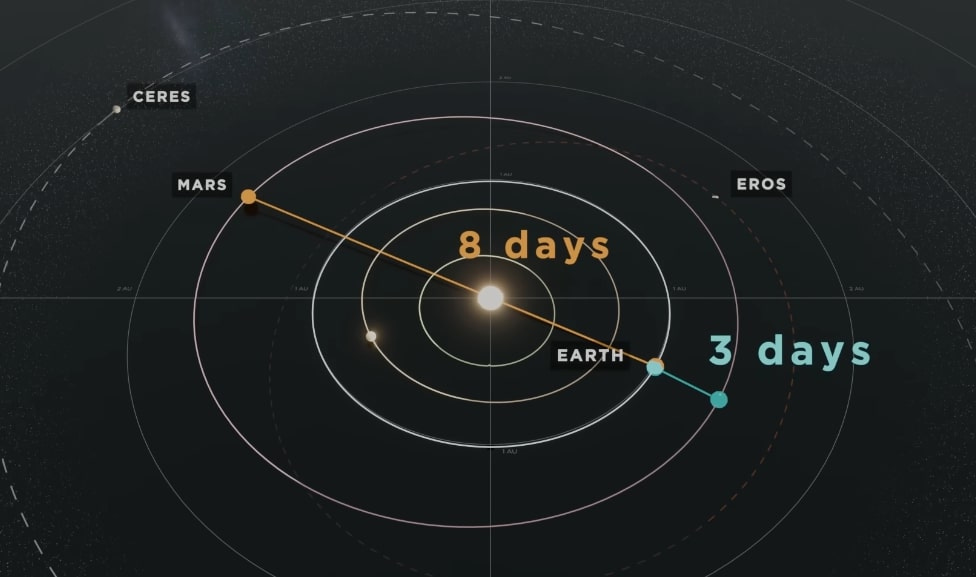Solar System Travel With Advanced Propulsion
By Brian Wang
If we achieve advanced nuclear, antimatter propulsion or other advance propulsion it would be possible to achieve near constant acceleration. This would enable travel times to Mars in the 3-8 day range depending upon where Mars was in its orbit relative to Earth. This would be with constant 0.33G acceleration and deceleration.
What exactly is a Brachistochrone Orbital Transer?
A Hohmann orbit is the maximum transit time / minimum deltaV mission. Weak spacecraft use this because they do not have a lot of deltaV. All current space probes use Hohmann because currently there ain't no such thing as a strong propulsion system.
A "Brachistochrone" is a minimum transit time / maximum deltaV mission. Torchships use this because they have lots of deltaV to spare.
A torchship is a spacecraft with <b>more</b> than 300 km/s total delta V and an acceleration greater than 0.01 g.
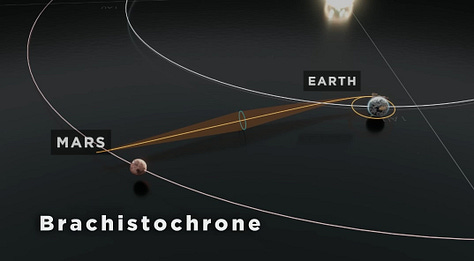
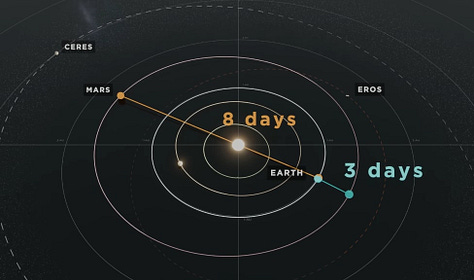
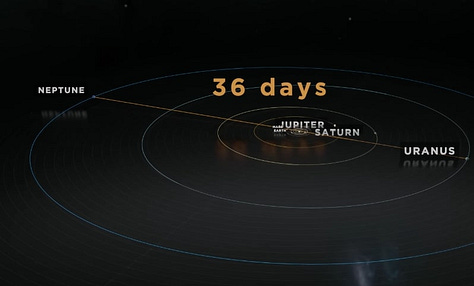
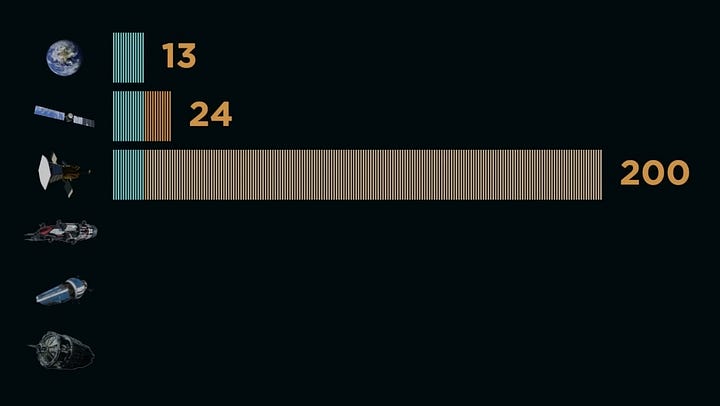
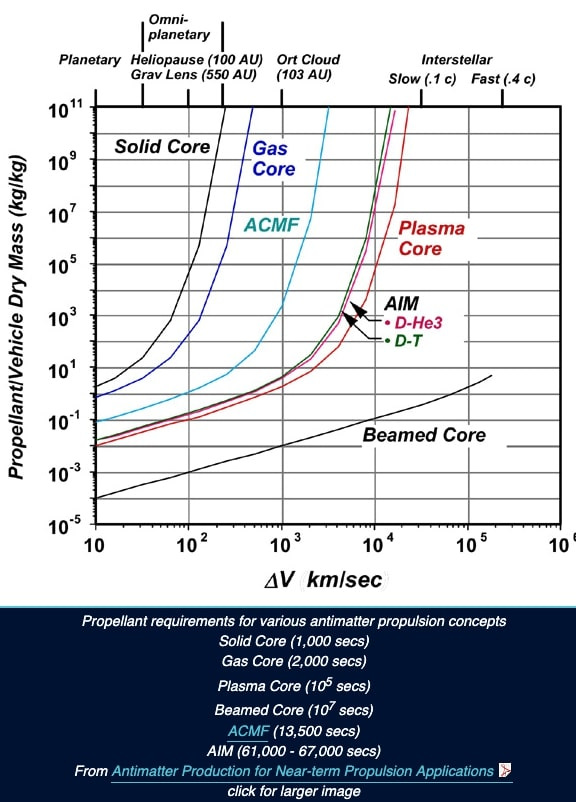
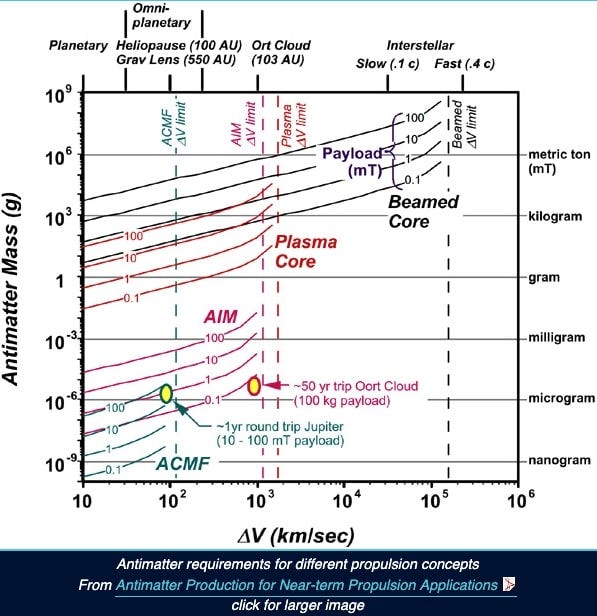
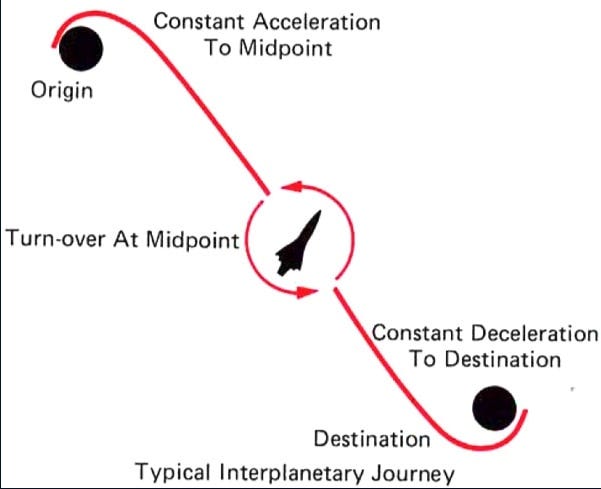
There is an online site for determining solar system travel times with advanced propulsion.
The most probable torchship designs proposed are nuclear pulse propulsion (e.g., Project Orion) and nuclear salt water rockets (NSWR). These leverage high thrust and exhaust velocity to achieve more than 300 km/s delta V and more than 0.01 g acceleration, enabling Brachistochrone transfers. Among nuclear rockets, those using nuclear fission, particularly Project Orion, are the most achievable with current technology due to their development in the 1960s and reliance on known physics. The NSWR is also fission-based and promising but less mature. Fusion-based propulsion (e.g., Daedalus) offers superior potential but awaits technological breakthroughs. Beamed power to ion drives or laser thermal rockets could work but demands advanced infrastructure, reducing near-term feasibility.
Nuclear Pulse Propulsion (e.g., Project Orion)
Description: This concept, developed in the 1950s and 1960s, uses nuclear explosions (typically fission bombs) detonated behind a spacecraft to propel it. A pusher plate absorbs the blast, transferring momentum to the vehicle.
Performance:
Exhaust velocity: Approximately 20–60 km/s, depending on the design (e.g., specific impulse of ~6,000 seconds yields ~59 km/s).
Thrust: Extremely high due to the explosive force, enabling accelerations well above 0.01 g (potentially up to 1 g or more, though typically lower for crew comfort).
Delta V: For interplanetary missions (e.g., Mars in 125 days), delta V is in the tens of km/s, but interstellar designs (e.g., Freeman Dyson’s analysis) suggest velocities up to 10% of light speed (30,000 km/s). With a mass ratio of ~160, a delta V of 300 km/s is feasible, though it requires significant propellant.
Fit for Torchship: Meets both criteria handily, supporting Brachistochrone trajectories (continuous acceleration to midpoint, then deceleration).
Status: Feasible with 1960s technology, making it one of the most developed proposals.
Nuclear Salt Water Rocket (NSWR)
Description: Proposed by Robert Zubrin, this system uses a solution of fissionable material (e.g., uranium salts) in water as propellant. The mixture undergoes a continuous nuclear reaction in a nozzle, producing a high-thrust exhaust.
Performance:
Exhaust velocity: Up to 4,725 km/s (based on theoretical estimates), far exceeding most fission systems.
Thrust: High, due to the continuous explosion-like reaction, supporting accelerations over 0.01 g.
Delta V: With an exhaust velocity of 4,725 km/s, a delta V of 300 km/s requires a mass ratio of just ~1.065, meaning very little propellant is needed, easily surpassing the 300 km/s threshold.
Fit for Torchship: Exceptional efficiency and thrust make it a strong candidate for Brachistochrone missions.
Status: Conceptually sound but untested; engineering challenges (e.g., containment) remain.
A nuclear salt-water rocket (NSWR) is a theoretical type of nuclear thermal rocket. A conservative design for the rocket would be fueled by salts of 20 percent enriched uranium or plutonium. The solution would be contained in a bundle of pipes coated in boron carbide (for its properties of neutron absorption). Through a combination of the coating and space between the pipes, the contents would not reach critical mass until the solution is pumped into a reaction chamber, thus reaching a critical mass, and being expelled through a nozzle to generate thrust.
The low 20% enrichment level is what is permitted for nuclear energy reactors. The system would achieve an ISP of about 67300. This would be about 20 times more efficient than most chemical rockets. Exhaust velocity would be 66 km/second.
The 300 ton design has a thrust of 2.9 Mlb, and a T/W of 40 is assumed. The specific impulse is 6730 s, and the tankage fraction is 0.04. The very high thrusts inherent in the NSWR causes this system to depart LEO with an acceleration of 3.4 Earth g’s. The total jet power output of the engine is 427,000 MW.
Deceleration could be accomplished without the use of substantial amounts of rocket propellant by using a magnetic sail (or “magsail”) to create drag against the interstellar medium.
In a more ambitious approach, one could envisage a group of interstellar emigrants selecting a small ice asteroid with a mass of 30,000 tonnes and using it as propellant (together with 7,500 tonnes of uranium obtained elsewhere) for a 300 tonne spacecraft. In this case the ship could obtain a final velocity of about 7.62% light speed, and reach Alpha Centauri in about 60 years.
Keep reading with a 7-day free trial
Subscribe to next BIG future to keep reading this post and get 7 days of free access to the full post archives.


